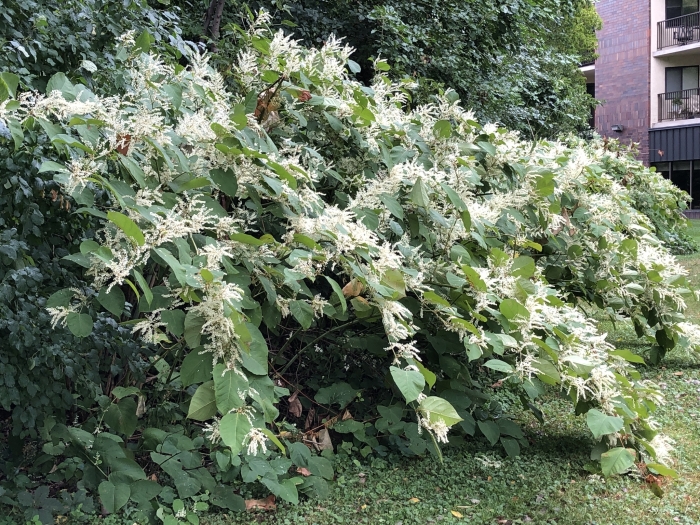Bohemian Knotweed
(Reynoutria ×bohemica)
Bohemian Knotweed (Reynoutria ×bohemica)
/
/

© Bob
CC BY 4.0
Image By:
© Bob
Recorded By:
Copyright:
CC BY 4.0
Copyright Notice:
Photo by: © Bob | License Type: CC BY 4.0 | License URL: http://creativecommons.org/licenses/by/4.0/ | Uploader: rnheld | Publisher: iNaturalist |
























Estimated Native Range
Summary
Reynoutria × bohemica, commonly known as Bohemian knotweed, is a hybrid between Japanese knotweed (Reynoutria japonica) and giant knotweed (Reynoutria sachalinensis). It is a herbaceous perennial that can exceed 11.5 feet in height and is characterized by its larger leaves compared to Japanese knotweed. Bohemian knotweed produces clusters of small, creamy white flowers in late summer, typically around August, which are less showy than some ornamental plants but still of interest due to their profusion. This plant is native to Japan and has become widespread globally, often found in disturbed sites, along waterways, in waste areas, and in urban environments where it can outcompete native vegetation.
Bohemian knotweed is recognized for its rapid growth and ability to stabilize soil, which can be beneficial in certain erosion control scenarios. However, its extreme invasiveness and vigorous growth habit make it a problematic species in many regions. It is often used in urban areas for its ability to thrive in poor soil conditions, but caution is advised due to its invasive nature. In cultivation, it requires minimal care, tolerating a range of soil types and moisture levels, but it prefers full sun to part shade. There are no popular garden cultivars due to its invasive characteristics. Potential problems include its aggressive root system, which can damage foundations, pavements, and drainage works. It is also difficult to eradicate once established due to its extensive rhizome network.CC BY-SA 4.0
Bohemian knotweed is recognized for its rapid growth and ability to stabilize soil, which can be beneficial in certain erosion control scenarios. However, its extreme invasiveness and vigorous growth habit make it a problematic species in many regions. It is often used in urban areas for its ability to thrive in poor soil conditions, but caution is advised due to its invasive nature. In cultivation, it requires minimal care, tolerating a range of soil types and moisture levels, but it prefers full sun to part shade. There are no popular garden cultivars due to its invasive characteristics. Potential problems include its aggressive root system, which can damage foundations, pavements, and drainage works. It is also difficult to eradicate once established due to its extensive rhizome network.CC BY-SA 4.0
Plant Description
- Plant Type: Herb
- Height: 5-10 feet
- Width: 3-6 feet
- Growth Rate: Rapid
- Flower Color: White
- Flowering Season: Summer, Fall
- Leaf Retention: Deciduous
Growth Requirements
- Sun: Full Sun, Part Shade
- Water: Medium
- Drainage: Medium, Fast
Common Uses
Erosion Control
Natural Habitat
Disturbed sites, along waterways, waste areas, and urban environments
Other Names
Common Names: Hybrid Knotweed
Scientific Names: , Reynoutria ×bohemica, Fallopia japonica × sachalinensis, Fallopia sachalinensis var. intermedia, Fallopia xbohemica, Fallopia ×bohemica, Polygonum sachalinense var. intermedium, Polygonum ×bohemicum, Reynoutria sachalinensis var. intermedia, Reynoutria xbohemica
GBIF Accepted Name: